Caspian Energy (CE): Caspian gas supplies to the EU have started under 2013 contracts. How do you see the future of the Southern Gas Corridor in the EU?
Kadri Simson, EU Commissioner for Energy: The Southern Gas Corridor fits into the Commission ambition of diversifying our sources of energy supply – thereby allowing us to meet our basic energy ambition of a secure, safe and affordable supply of energy across the whole EU.
In the longer term, under the heading of the European Green Deal, the EU is committed to achieving carbon-neutrality by mid-century. Natural gas is expected to play a role in the transition in the coming decades, in particular in regions where a quick replacement of coal by gas can bring significant emission reductions. However, on the path towards climate neutrality, natural gas will have to be increasingly replaced by renewable and low-carbon gases. The EU is already actively engaged with its international partners on the energy transition and ready to cooperate through the dialogue and high-level meetings available.
CE: Do you consider the possibility of mass cultivation of marine biocultures, since their individual varieties, unlike oil, contain almost 1,000 times more biodegradable pure oil?
Kadri Simson: We still have some way to go before these technologies are commercially viable, but we are convinced of the significant potential that this technology offers.
The EU is perfectly suited for such a scale up of seaweed production. It has ideal growing conditions, with nutrient-rich, cold waters, but also a developing innovation community, including start-ups and SME players across the value chain. The demand for seaweed-based products is increasing fast and boosting the seaweed sector is in strong alignment with several European Green Deal objectives and priorities.
In addition, seaweed farms can easily co-exist with other water-based ventures such as windfarms, to benefit from labour and equipment synergies, reduce environmental impact and create cost efficiencies.
Recently, when adopting our EU Offshore Renewable Strategy, the European Commission fully recognised the role of biofuels from algae as a future ocean energy source.
CE: The development of the seaweed industry also helps in the fight against water pollution, and in the production of natural bio-products in the light and food industries. How effective is this business?
Kadri Simson: Seaweed has an important role to play in water pollution remediation and in carbon sequestration, which could be enhanced by scaling-up production, as well as the conservation of their ecosystem.
Currently, 98% of EU macro-algae production comes from harvesting rather than aquaculture. The Commission is revising its strategic guidelines for Member States on sustainable aquaculture, which will also cover seaweed. In addition, the Commission is planning to issue a Communication specifically on algae in early 2022, in the context of the European Green Deal.
The seaweed business in Europe is growing at a steady rate, but it still needs more research, investments, scaling up and streamlining the legislation.
CE: What practical future do you predict for clean hydrogen, wind power and solar generators in the EU?
Kadri Simson: The EU has adopted a new and more ambitious emissions reduction target of at least -55% by 2030, compared to the 1990 baseline. To achieve this higher ambition, renewables deployment needs to be accelerated. We expect that a doubling of annual markets for solar and wind is needed. We also see particular opportunities to rapidly scale up offshore wind and emerging ocean energy technologies are promising.
In addition, we put high hopes in renewable hydrogen that can support the decarbonisation, in particular, of heavy industry and some sectors of transport across Europe. In the European Hydrogen Strategy adopted earlier this year we set a timeline for the gradual upscaling of renewable hydrogen in our economy:
From 2020 to 2024, we will support the installation of at least 6 gigawatts of electrolysers in the EU for the production of up to one million tonnes of renewable hydrogen.
From 2025 to 2030, hydrogen needs to become an intrinsic part of our integrated energy system, with at least 40 gigawatts of electrolysers for the production of up to ten million tonnes of renewable hydrogen in the EU.
From 2030 to 2050, renewable hydrogen technologies should reach maturity and be deployed at large scale across all hard-to-decarbonise sectors.
By 2030, wind energy in the EU is expected to have an installed capacity of around 433 – 439 GW (up from around 170GW today), with most of the installed capacity being located onshore (361 – 365 GW). For offshore energy specifically, we have recently adopted a dedicated strategy that aims to reach at least 60GW offshore wind and 1 GW of ocean energy capacity by 2030, and 300 GW and 40GW respectively by 2050.
By 2030, solar energy in the EU is projected to grow to 363 – 370 GW (up from around 130 GW today).
CE: According to the UN, the petrochemical industry accounts for 48% of carbon emissions into the Earth’s atmosphere, while cars account for 28% and only the rest falls to the share of coal, other industries and agriculture. Which measures are taken in the EU to reform petrochemical production?
Kadri Simson: Based on the impact assessment of the Climate Target Plan, every sector will have to contribute to the energy transition. Our figures for the EU are quite different to the ones that you refer. For example, in 2015, the transport sector accounted for about 23% of the total greenhouse gas (GHG) emissions; residential and service sector for 13%; and the sectors covered by the EU Emissions Trading System (ETS) (excluding aviation) for 44%. A large part of these GHG emissions are due to fossil fuel combustion and different instruments will be used to reduce these emissions. The EU is currently reviewing its entire legislative framework on energy and climate action to make it fit for our more ambitious targets. We are for example evaluating extending the scope of the EU ETS to cover a larger share of emissions, as well as reviewing energy efficiency and renewable energy measures.
These initiatives will have an impact on the indirect emissions of the petrochemical sector. Direct emissions already fall under the EU ETS. The combined effect of these policies implies that this sector will have to decarbonise and transform in the long term, but also that the clean energy transition will provide new business opportunities for the sector. According to our analysis, for example, hydrogen and gaseous fuels of renewable origin will be an important energy sector in the future and the Commission is planning actions (e.g. with the Hydrogen and Industrial strategies) to help all sectors of the EU economy in the transition.
Thankyoufortheinterview





